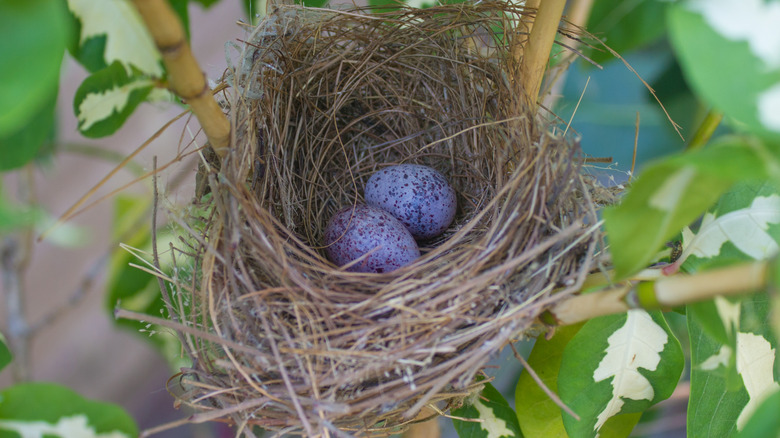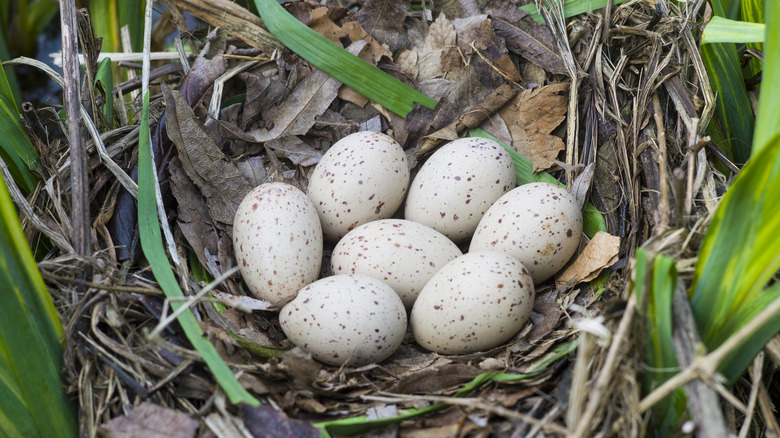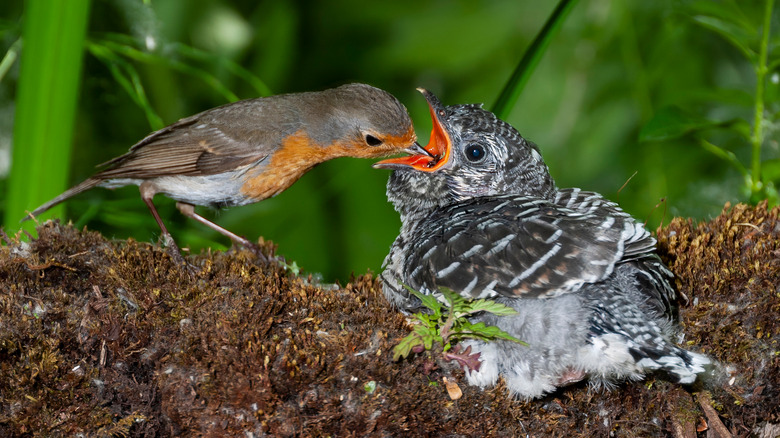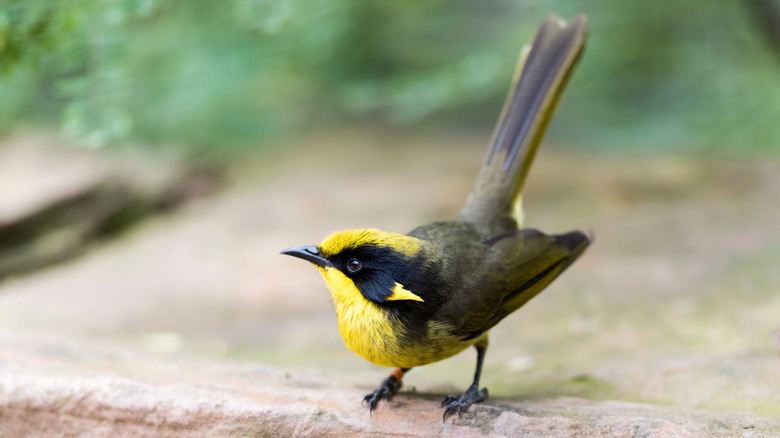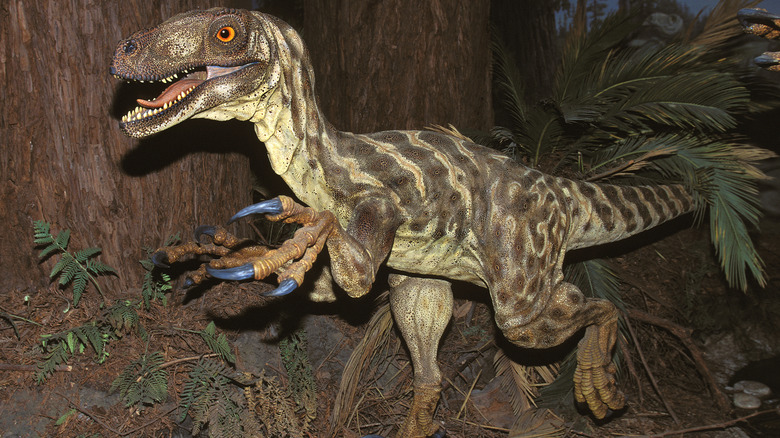The Evolutionary Reason Some Bird Eggs Are So Colorful
One of the most beautiful woodland sights is a nest full of sky blue robins' eggs peaking up out of the brown and green. This trait is unique to birds, according to The Conversation. No other existing vertebrates lay colorful eggs. But why do birds like robins lay such beautiful eggs? There are many possible reasons, but ultimately the answer comes down to one thing: natural selection.
Natural selection is how species evolve to be best adapted to their environment, according to National Geographic. Every individual has unique traits, and sometimes these traits help an organism survive and thrive in a particular ecosystem. Individuals with these desirable traits are more likely to live longer and reproduce, therefore passing on their traits to the next generation. Over time, this process can lead to the emergence of new species. One classic example is the finches that English naturalist Charles Darwin observed in the Galapagos. Each species of finch has evolved a uniquely shaped beak based on their food and environment, according to The Guardian. The thick beak of the ground finch helps it gobble up seeds and arthropods, while the thin beak of the warbler finch aids it in catching insects hiding in foliage. So scientists looking to understand why birds hatch eggs with certain colors need to answer why a certain color would help those eggs survive.
Two pigments, many patterns
There are many different hypotheses as to why birds' eggs have evolved to be specific colors, but one thing that scientists clearly understand is how they get that way. The surprising truth is that every bird egg under the sun is decorated with just two pigments, according to The Cornell Lab. These are biliverdin, which produces the blue-green of robin's eggs, and protoporphyrin, which produces a reddish-brown hue. Most birds have the ability to produce both pigments.
The addition of these pigments is the last step in the bird's egg-making process, usually occupying the last two or three of 24 hours. Speaking to the Cornell Lab, University of Sheffield zoologist Tim Birkhead said that the pigments were applied the way we might spray paint on a wall or object using "paint guns." However, there is not a lot of artistic license involved. The guns are timed to fire at a specific point in the process and in a specific order so that an egg will emerge with its distinctive background color and pattern of speckling. It also happens very quickly, which makes it difficult to study. "Examination of birds' oviducts at the time the color is placed on the egg suggests that the color is produced and released over a very short time frame," Birkhead told The Cornell Lab.
The temperature factor
These two pigments give birds a surprising number of coloration options, so why did certain species evolve to favor certain designs? According to a study published in Nature Ecology & Evolution in 2019, one factor is temperature. The researchers looked at 634 species of birds from around the world and found that birds living in cooler climates tended to have darker eggs. "Eggs in these colder places are darker brown, and then as you go toward the tropics and even the temperate zone, there are just more competing selection pressures, so there is more variation in colors," study co-author Dr. Daniel Hanley of Long Island University told The Guardian.
The tendency for birds to lay darker eggs in colder climates was especially the case for birds whose nests were exposed to the sun in some way, according to the study. The reason, the researchers suggested, is that birds' eggs need to maintain a temperature of around 90 degrees Fahrenheit in order to hatch, Discover pointed out. Darker colors in colder, darker climates would therefore absorb the limited sunlight and keep the eggs nice and toasty. The researchers also supported their findings by exposing differently hued duck, chicken, and quail eggs to sunlight and confirming that the darker eggs maintained a higher temperature for longer. For tropical birds, dark colors can still help camouflage against predators. They also have molecules that are triggered by light and guard against disease. Therefore, some tropical birds have still evolved to lay darker eggs.
The parasite factor
Some birds practice a strategy known as "brood parasitism," according to Salon. This is when one species of bird lays its eggs in another bird species' nest in order to trick the parent into taking care of its offspring. Cuckoos are some of the most notorious brood parasites. They are the reason that a man whose wife has cheated on him is called a cuckold, according to Paste. The survival of both parasitic species like the cuckoos and their unwilling foster species depends on whether or not the host mother recognizes the strange eggs. This has led to an evolutionary "arms race" in which host species develop the ability to recognize and reject foreign eggs, parasitic species evolve the ability to copy these eggs, host species evolve even more unique and complicated eggs, and parasitic species evolve to mimic these in turn, according to a paper published in the Philosophical Transactions of the Royal Society B.
The end result of this "arms race" is some seriously beautiful eggs. University of Cape Town professor Dr. Claire Spottiswoode, who studies brood parasitism in birds, told Salon that she got a "thrill" every time she saw one of the elaborately-decorated parasitic eggs hiding in a nest. "It's just a total joy to see the beautiful adaptations that natural selection has forged over hundreds of thousands of years," she said.
The nest-shape factor
Another reason that birds evolved colorful eggs could be changes in the shape of their nests over time. Research published in Evolution in 2021 found that the eggs of Australian songbirds got more colorful over time as their nest shapes changed. Today, when we think of birds' nests, we think of the cup shape that is open at the top, making the eggs visible to anyone peering inside. However, this was not the preferred nest-construction method around 40 million years ago, study author Kiara L'Herpiniere of Macquarie University wrote in The Conversation. Instead, birds built domed nests that hid their eggs from prying eyes.
The researchers looked at both the nest type and egg color of 269 species of Australian passerines found in museum collections. They found that the birds that built domed nests tended to lay white eggs, and a switch to open nests evolved alongside more colorful eggs. "As nests transitioned from domes to cups, there was an increase in the range of egg colors observed, presumably as a response to additional stressors," the study authors wrote. The neat thing about this theory is that it can account for all the other reasons that birds evolved to have colorful eggs. Open nests expose the eggs to predators, colder temperatures, and parasitic cuckoos, for example.
Jurassic origins
There are other reasons that birds might have evolved colorful eggs. For example, there is evidence that the blue-green color of robin's eggs signals to potential mates that the mother is healthy, according to The Conversation. This is because biliverdin has antioxidant properties, according to a 2008 study published in Ornithological Applications. Therefore, males that see clutches with blue-green eggs will know that the mothers are able to take care of their young. Scientists found that this was the case for gray catbirds. Mothers with more antioxidants laid bluer eggs, and males were more likely to care for those eggs. Pigment may also be a way that mothers can thicken an eggshell, a 2011 study of great tits published in Avian Biology Research found.
While egg color is now unique to birds, it may have also evolved in their ancient ancestors: dinosaurs. The first evidence of dino egg coloring emerged in 2017 when a study published in PeerJ found evidence of biliverdin and protoporphyrin in the eggshells of oviraptorid dinosaurs. A follow-up study found even more examples of painted dinosaur eggs, including blue-green eggs laid by the Velociraptor relative Deinonychus, according to Science. This means the trait emerged more than 150 million years ago, and for the same reasons, it has persisted in birds. As some dinosaurs switched to open nests, they evolved new ways to protect them from predators and parasites. "[This] is a true discovery," University of Illinois in Urbana ornithologist Mark Hauber told Science.
